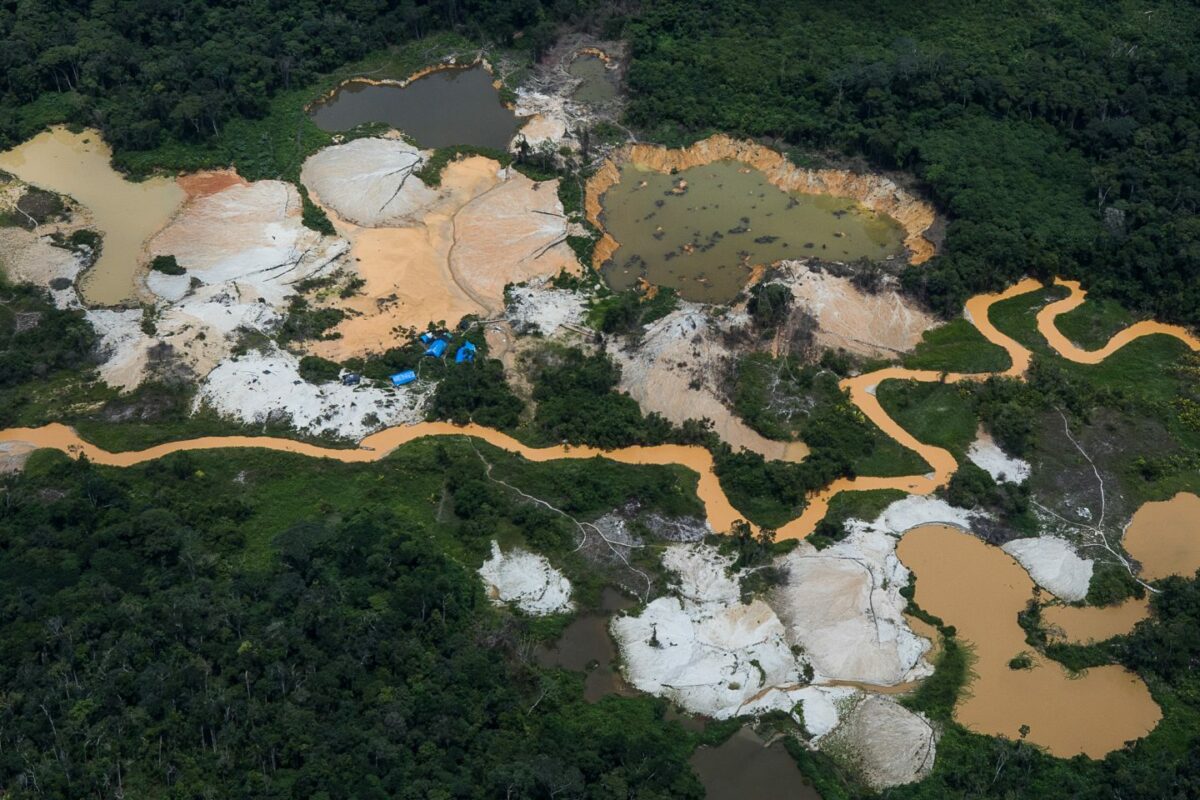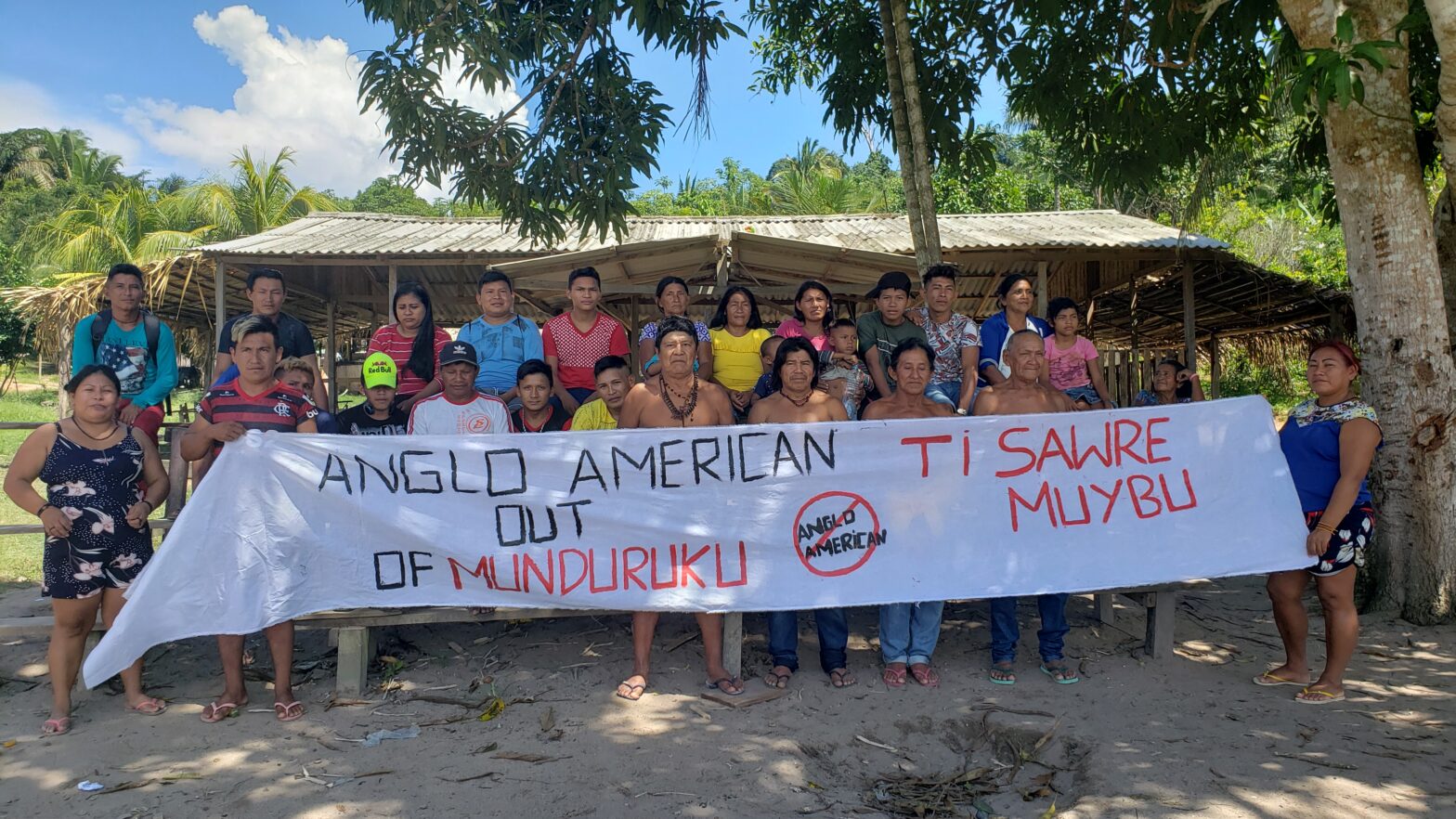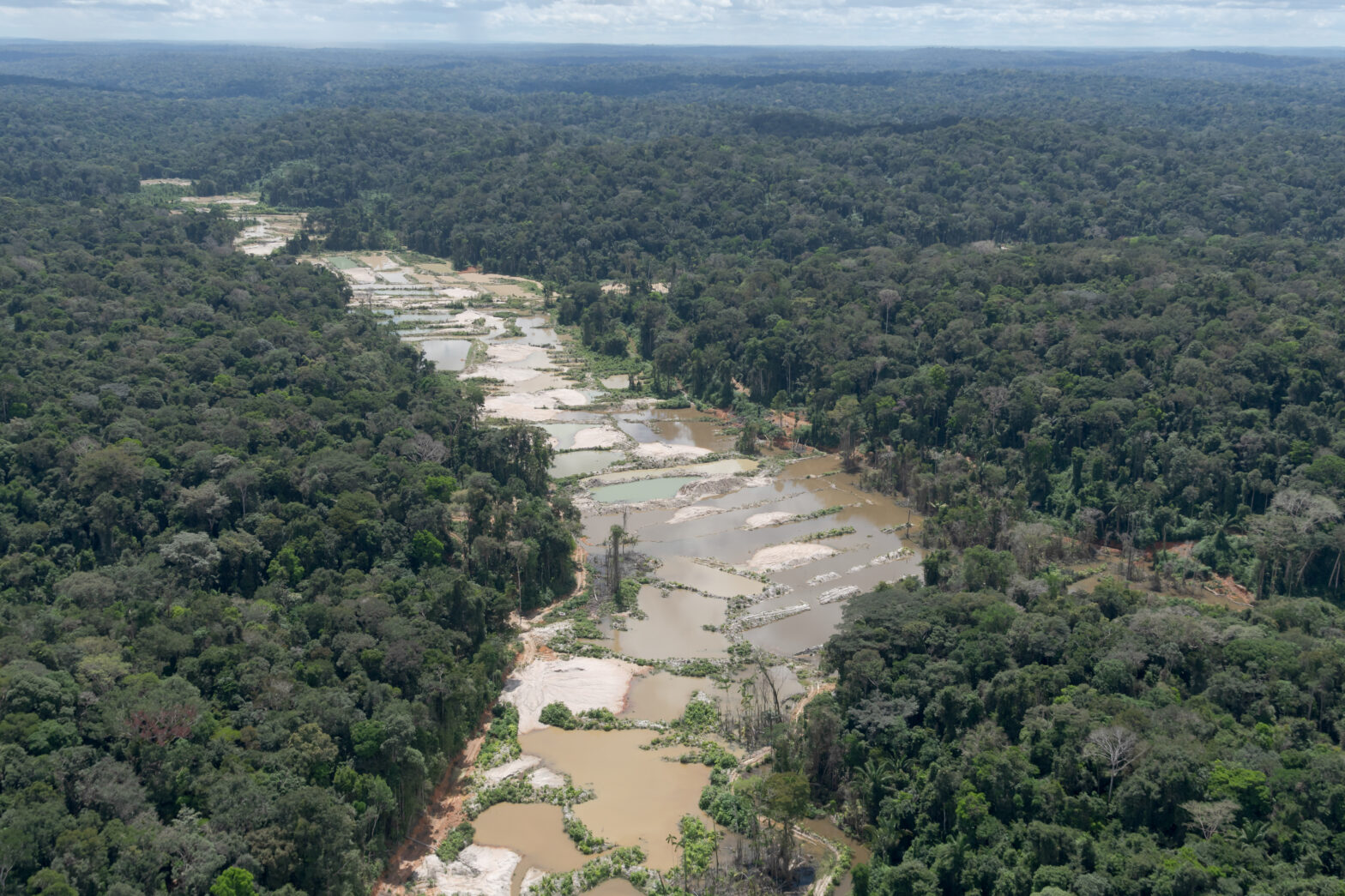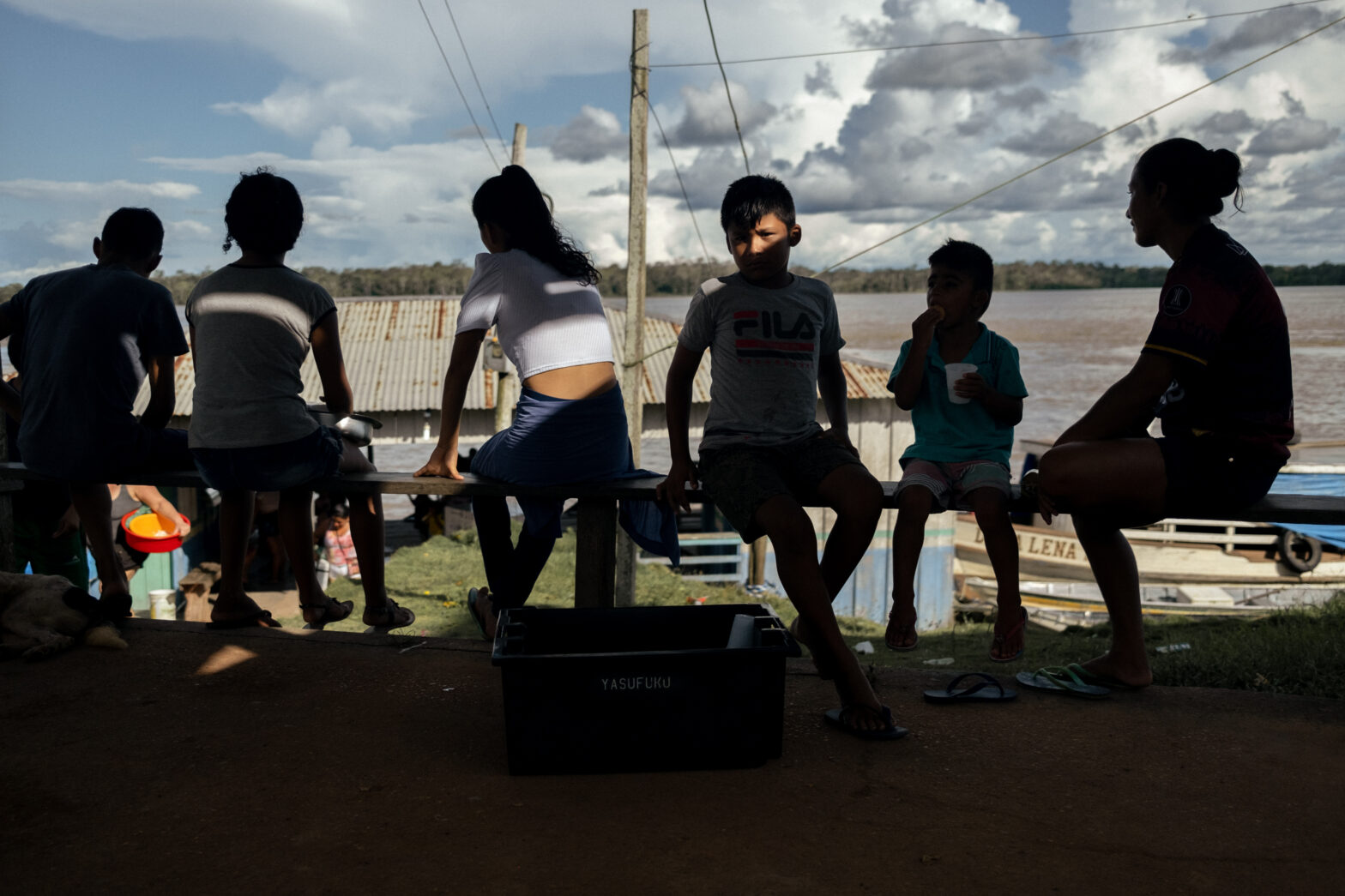Forty three percent of all mining requests on the indigenous lands in the Brazilian Amazon lands are for gold extraction, an InfoAmazonia data analysis reveals. In several of these targeted areas, satellite images show that there is gold mining already taking place without authorization.
Meanwhile, Brazil’s far-right President, Jair Bolsonaro, has pushed for a law that would allow mining on indigenous lands, on the grounds that the War in Ukraine could cause a shortage of fertilizer supplies, especially potassium. “This crisis is a good opportunity for us,” he said.
On March 7, as Russian troops invaded Ukraine, the price of gold surpassed the historic high of US$2,000 an ounce (31 grams). Such a high price had only been registered in August 2020, when the prices crossed that threshold for the first time as a consequence of the global pandemic. In times of global uncertainty, gold is considered a safe haven because it is less volatile than other investments. It is also what mining companies most hope to find in the indigenous lands of the Brazilian Amazon.
But Brazil’s President Jair Bolsonaro did not mention any of that when advocating for rushing through a bill that would allow mining on indigenous land. As soon as the war in Ukraine started, President Bolsonaro alleged that mining expansion in the protected areas was necessary because Brazil was at risk of a fertilizer crisis due to a lack of potassium. The country imports some 85% of its fertilizers and about a fifth of that comes from Russia. To avoid the crisis, the president said, Brazil should approve the bill known as PL 191/2020, designed to open up indigenous lands to mining and infrastructure works. In his speeches, he omitted that the biggest beneficiaries of this bill would be gold mining operations.
Data from Amazônia Minada, an InfoAmazonia project that tracks mining permit requests in the Brazilian Amazon indigenous lands, reveals that 2,467 mining requests registered with the National Mining Agency (ANM) are on indigenous lands or contiguous territories. Of these, 1,067 (43 percent) are for gold mining.
These permit requests came from a total of 280 applicants, including mining companies, prospectors, and cooperatives, who seek authorization to exploit 3.7 million hectares in the Amazon, an area almost the size of Switzerland. The Yanomami, Munduruku, and Kayapó indigenous lands are the communities most targeted by the gold mining permit requests.
Land disputes are frequent in these areas. In the Yanomami land, which has been the target of miners for more than 40 years, illegal mining has intensified since 2020. Data from the Amazônia Minada show that prospectors and mining companies have asked for mining permits throughout [or across] almost the entire territory of the indigenous community.
Including all types of ores, the mining requests aim to exploit areas on 254 of the 385 indigenous lands in the Amazon, putting 65 percent of their territories under pressure from the mining operations and the (illegal) gold prospectors. The permit requests for gold mining target 156 of these protected territories. In other words, 40 percent of the Amazon indigenous lands are targets of the gold rush.
Cassiterite, a component of tin, for example, is the second most sought-after metal in protected lands. There are 169 requests to exploit an area of 716 thousand hectares. Potassium, which was singled out by Bolsonaro as a strategic mineral for the production of fertilizers, appears in fourth place. Of the more than 550 applications filled with the ANM to exploit potassium, 73 are overlapping or in areas adjacent to indigenous lands.
The assistant secretary of the Indigenous Missionary Council (Cimi), Luis Ventura, says “it is unacceptable for the federal government to use war to justify mining in indigenous lands.” He points out that this greater pressure on the rights of indigenous peoples was already expected this year, since President Bolsonaro is finishing his term (and preparing for his re-election campaign).
It is unacceptable for the federal government to use war to justify mining in indigenous lands.
Luis Ventura, secretary of the Indigenous Missionary Council (Cimi)
“We know this rhetoric about the lack of fertilizers to approve the mining bill is totally false,” Ventura says. “This project will be a disaster for traditional peoples and for the environment because we know well the pressure that mining already causes. It will be the end of the indigenous land.”
In addition to permitting mining on indigenous lands, Bill 191 also seeks to authorize, through legislative decrees, ventures for the exploration of oil, gas, hydroelectric plants, and agriculture projects in indigenous territories.
“If it is not for mining, it will be for other infrastructure projects, as foreseen in the bill. This will profoundly affect the way of life of traditional peoples,” says Ventura.
A study published in the scientific journal One Earth points out that mining on indigenous lands has the potential to increase deforestation in the Amazon by 20 percent above previously recorded levels.
Illegal gold from the Amazon
Despite the fact that exploiting indigenous lands is prohibited, InfoAmazonia has found that gold exploration is already taking place, illegally, in several of these areas required by the National Mining Agency, through industrial-scale mining. Satellite images show signs of gold exploration that do not have any type of authorization in areas in the states of Roraima and Pará.
The ore from these areas, which are the focus of Bill 191, goes a long way before legally entering the market. In Pará, for example, InfoAmazonia pinpointed an area where permits have been sought since 2016 within the Munduruku Indigenous Land. In September 2019, the ANM rejected the request for “total interference” with the indigenous territory. Even so, satellite images confirm that the area is largely being exploited by miners.
The National Committee for the Defense of Territories Against Mining Conflict report points out that illegal mining is one of the main reasons for clashes between miners and indigenous people in the Amazon. The activity also causes a series of negative impacts on environmental preservation and the health of these peoples, such as mercury contamination in rivers.
Luiz Jardim Wanderley, the coordinator of the Observatory of Mining Conflicts in Brazil, says that, in addition to the appreciation of gold in the international market, other factors such as economic crises, unemployment, and the lack of inspection contribute to the advance of the exploration of the metal in the Amazon. “The economic crisis that began in 2016, along with the rise in the price of gold and the dismantling of inspection departments, facilitates this mining spread,” explains Wanderley.
Gold laundry
The approval of Bill 191 promises to legalize much of the gold that is already being illegally exploited in the Amazon, opening new frontiers for this business. A survey by the Escolhas Institute shows that almost half of the gold production in the country has an illegal origin. But it points out that, since there is no accountability, the illegal market can be much greater. Of the more than 487,000 kilograms of gold sold in 2020, according to the Institute, 228,000 kilograms had evidence of illegal origin and more than a ton was determined to be from mining that overlapped indigenous lands and conservation units.
“Surveys show that the mining illegal area in Brazil is already larger than the area occupied by industrial mining. We no longer have a timid advance that does not cause impact,” says Juliana Siqueira-Gay, project manager at the Escolhas Institute. The organization asked the United Nations to classify Brazil as a conflict and high-risk area for gold imports.
Surveys show that the mining illegal area in Brazil is already larger than the area occupied by industrial mining. We no longer have a timid advance that does not cause impact.
Juliana Siqueira-Gay, Escolhas Institute project manager
Siqueira-Gay emphasizes the need to adopt legal and reliable mechanisms to track gold in the market. The Institute has demanded that the government, investors, and banks also ask themselves where the gold they trade comes from. “It is essential that we bring this into the debate, this awareness of people’s lives. If everyone who buys a wedding ring asks questions, we will force this screening of the production chain,” explains Siqueira-Gay.
The Escolhas Institute, in partnership with Senator Fabiano Contarato, from the Worker’s Party (PT), worked on fine-tuning a bill that seeks to regulate the commercialization of gold in Brazil. The bill regulates the buying and selling of ore, mandating that it be linked to valid permits, and that the weight of the ore be verifiable by the authorities. Currently, the chain of trade is not digitized. As many documents are still handwritten, it relies on good faith in the information provided by prospectors and buyers of this gold.
An indicator of Brazil’s gold production is the amount collected by the Financial Contribution for Mineral Exploration (CFEM). The revenues data show record gold production in the Amazon over the past three years. Even so, some of the undeclared ore goes straight to jewelry stores and is smuggled through illegal routes. “Today, the information we have is from these estimates [from CFEM], but naturally, when we have this issue of good faith, the origin itself makes it difficult for us to understand what is actually happening,” says Siqueira-Gay. “The digitization of all this information would make it easier,” she adds.
This story was produced with support from Report for the World, an initiative of The GroundTruth Project.





